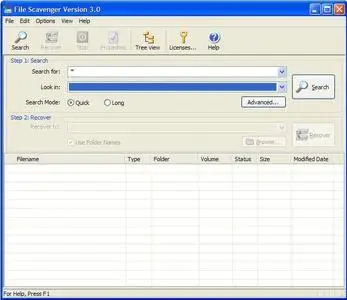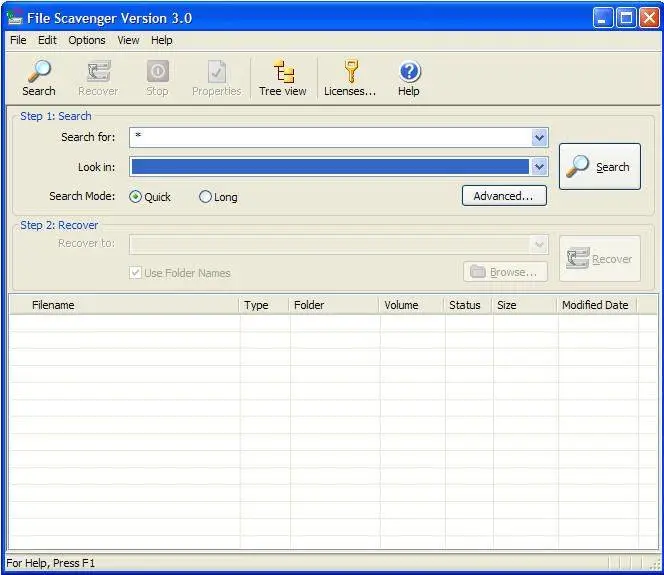File Scavenger® Version 3 is the most comprehensive, award-winning file undelete and data recovery utility for Windows XP®, Windows 2003, Windows 2000® or Windows NT®. File Scavenger® can recover files accidentally deleted, including files removed from the Recycle Bin, in a DOS window, from a network drive, from Windows Explorer with the SHIFT key held down, provided that recovery is attempted before the files are permanently overwritten by new data. File Scavenger® supports both basic and dynamic disks, NTFS compression, alternate data streams, sparse files, Unicode filenames, etc. Except in severe cases, both the file and the folder path leading to the file can be recovered. English and German versions are available.
With File Scavenger®, files can be recovered from reformatted or corrupted volumes. This is even possible when a volume has been deleted and its original position and size are unknown. File Scavenger® can scan an entire physical hard drive to look for traces of defunct volumes. File Scavenger® has advanced algorithms to transparently handle disks with many bad sectors and badly corrupted partitions. The software can be installed on a hard drive or run from a floppy disk. To run File Scavenger®, you must log on as a system administrator to the computer where data recovery is intended. Disclaimer: Files can only be restored if the disk areas allocated to the files have not been overwritten by new data. When a file is restored, it is not guaranteed that the content of the recovered file is the same as the original. It is your responsibility to validate the integrity of the data prior to using it Important Notice: The determining factor of successful data recovery is that the volume (i.e. a drive letter such as C:, D:, E:, etc., also referred to as a "drive" or "partition") where the deleted data resided has not been modified. When modifications are made to the volume, the deleted data may be permanently overwritten because the disk clusters they occupied may be reallocated. Common scenarios when this may occur are: New files are created on the volume. Existing files are expanded. New software (including File Scavenger) is installed on the volume. If the volume contains a network share, network users may unknowingly modify the volume when accessing shared files. Applications running on the computer may update the volume. If the volume is the system volume, Windows may modify the volume for internal housekeeping tasks. If the volume contains the Internet Explorer cache, it may be modified when IE is started. If the volume contains the "TEMP" directory, it may be modified by installation software. The safest way we recommend to recover files is as follows: First, stop any activities that may write to the volume to be recovered. Watch out for: Network users accessing shares on the volume. Applications on the local computer. The Windows operating system if the volume contains the system folder or the page file. In this case you may have to shutdown the computer, remove the drive and install it on another computer for recovery. Download the floppy version of File Scavenger onto the hard drive on a second computer. Extract and copy the files onto a blank floppy disk. Insert the floppy disk to the computer with the volume to be recovered. Run File Scavenger from the floppy drive. (Click Start, Run and type "a:\filescav.exe".) Once any files have been found by File Scavenger, restore them to a different volume. (Recovering files to the same volume may cause deleted data to be overwritten and unrecoverable.)
Features:
Recovers the original filename and folder path.
Recovers files deleted from a network share. (File Scavenger must be run on the computer where the share is defined.)
Recovers files deleted in a DOS command window.
Recovers files removed from the Recycle Bin.
Recovers files deleted from Windows Explorer with the SHIFT key held down.
Recovers data from reformatted volumes.
Recovers files from deleted volumes.
Is especially effective in recovering digital images in JPEG format.
Recovers files from broken striped volumes (RAID 0 or RAID 5) or volume sets (spanned volumes).
Supports NTFS compression.
Provides English, German, Japanese and French versions.
Supports both basic and dynamic disks.
Transparently handles bad sectors when possible. Otherwise allows the user to skip ranges of bad sectors.
Scans badly damaged partitions.
Supports alternate data streams and sparse files.
Can search for file patterns or file types.
Recovers multiple files in one click.
Can sort files by date, size, name, type, path, etc.
Restores the original Create and Modified dates.
Supports Unicode filenames.
Scans very large volumes (hundreds of gigabytes) holding up to a few million files or more on a computer with sufficient RAM.
Detects certain file types based on their data patterns, thus allowing recovery even when the file system structure is totally lost.
Saves a search session to a disk file for reloading later so that a drive needs not be scanned again.
Scans disk image files.
Supports FAT and FAT32, but in a limited manner due to the inherent weakness in those file systems.
HERE IS 3 DOWNLOAD LINK NO MIRROR PLEASE
DOWNLOAD FROM HERE
DOWNLOAD LINK : DOWNLOAD EASY-SHARE .COM
DOWNLOAD LINK : DOWNLOAD DEPOSITFILES .COM
DOWNLOAD LINK : DOWNLOAD RAPIDSHARE.COM



